The Colombian F2 Temporada of 1971
When Formula cars roared in the Coffee Land
Author
- Lorenzo Baer
Date
- August 13, 2023
Related articles
- 1949 Brazilian Temporada - Brazil's forgotten racing days, by Lorenzo Baer
- The 1960-1975 South African Drivers Championships - Grand Prix at the Cape, by Mattijs Diepraam/Felix Muelas/Rob Young
- 1966 Argentinian F3 Temporada - It's never too late to revive old passions, by Lorenzo Baer
- 1967 Argentinian F3 Temporada - Time to go south again!, by Lorenzo Baer
- 1968 Argentinian F2 Temporada - The quick dash of the Cavallino Rampante in the Argentinian Pampas, by Lorenzo Baer
- 1969 Tasman Championship - Something that Chris Amon did win, by Tom Prankerd
- 1970-1975 Tasman Championship - Back to Pukehoke for a revival of F5000 Tasman days, by Gareth Evans
- Cuba, Bahamas, Puerto Rico - Racing Juniors in the tropics, by Lorenzo Baer
Who?Derek Bell, Frank Williams What?Frank Williams Racing Cars March-Cosworth 712M Where?Ricardo Mejia Circuit, Bogotá When?1971 Colombian GP (February 7, 1971) |
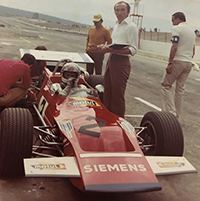 |
Why?
The year 1970 ended in a melancholic mood for drivers and teams alike. Even with spectacular races that would go down in the annals of motorsport history, the year was one of the most fatal in the history of racing. The death of three motorsports greats in a row – Piers Courage and Bruce Maclaren in June, Jochen Rindt in September – was a heavy blow to all categories.
But as the year drew to its close, it was up to reflect and learn from the mistakes of the season so that, in the future, these would not be repeated. Therefore, nothing better than a fresh start to mitigate the tears of the past. And so it was, when Colombia presented itself to host two Formula 2 events at the beginning of 1971. The history of this mini-championship is covered with peculiar, exquisite and exotic factors – something that fits perfectly in the context and history of F2.
Colombia, until the end of the sixties, had no tradition in motorsport. Even in the internal environment where races were pretty rare – and when they did happen, they were under extremely precarious conditions, much depending on the love of local drivers for the sport, and the dedication of the local auto club Los Tortugas (translating to English, The Turtles).
This was due to two simple factors: the first one was Colombia's poor automobile industry, the second was the lack of race tracks that could democratise the sport in the most different parts of the country. Feeling that it was lagging behind other South American countries in this regard (such as Brazil, Argentina, Uruguay and Peru, where regional championships were already established) Colombia quickly made up for lost time, with the primary objective of establishing a solid foundation for the future expansion and dissemination of motor sports in the land of coffee.
Of the two paths to be taken, the one that was considered more urgent was the creation of an international race track, which could host races of intercontinental categories inside the country. This, it was assumed, would attract a fair amount of international attention, which would consequently generate a wave of potential Colombian talents spurred on by these races. Theoretically, this would give rise to the first wave of genuinely Colombian pilots.
Proportionately, plans for the development of the domestic automobile industry would be set aside, at least for the time being. As it soon turned out, this high stakes move proved fatal, as the other forces in South American motorsport quickly quelled this act of Colombian insubordination. But that's not what the text is about, so let's go back to the dreams of 1970-71.
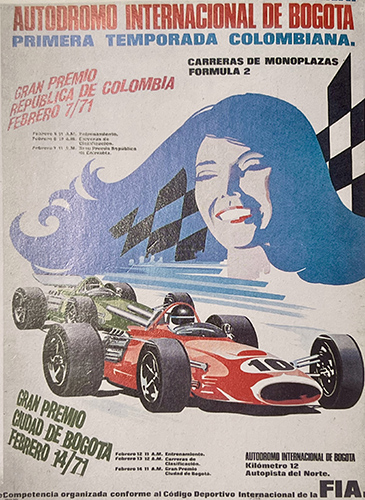
The official poster for the Colombian Temporada.
With the idea of the circuit firmly in the minds of the Colombian authorities, authorization was quickly given for the construction of the desired track. To create the layout, the same firm that designed the Ontario Motor Speedway was hired (the track had just opened in California, in August 1970), moreover, some observers from the Monza circuit were invited to accompany this first phase of the works, among them Giuseppe Bacciagaluppi, chief technician of the circuit at the time.
The approved design comprised two main circuit variations: the first consisted of an outer ring, with two open 90° turns, plus a long radius 180° bend. This variant (A) was 2,300m long. The second variant (B) was slightly larger, as it featured an infield section, which increased the length to 3925m.
It was possible to alternate the layouts by means of a simple change, since the exit and entrance of the infield section were next to each other, before the first 90° turn. In addition, there were two other circuit variations, that could be used in smaller national events.
Now it was up to choosing the place where the track would be built. It is at this point that one of the pivotal figures for the realisation of the dream of Colombia hosting an international automobile event appears: Ricardo Mejía.
The Colombian businessman who had investments in the country's business and agriculture areas was not a person who appeared as an adventurer in this project. On the contrary, Mejía had already worked with the Colombian government in works of urban mobility in the beginning of the thirties, more specifically, when he was one of the owners of Warren Brothers, one of the subcontractors of the Colombian government for asphalt paving in Bogotá.
Therefore, even before the circuit was built, Ricardo Mejía knew the size of the project. His first symbolic contribution was the donation of land, which was close to the original location where the races were held, at Club Los Tortugas.
The task should be completed in a record time, as the target date was the end of 1970; so that the track would be approved to host its first international event at the beginning of the following year. And, even with the delays, which are always present in this type of undertaking, the promise was fulfilled: in January 1971 the place was already cleared to host official events.
And because of his strong contribution to the project, Ricardo Mejía was honoured as his name was chosen to baptise the circuit. And so the interest arose for the circuit passing through its first international screening, and that would be through Formula 2.
Drivers and teams
Today, Formula 2 is basically overshadowed by the glamour and splendour of Formula 1. But we have to take into account that the context of this relationship was completely different 50 years ago, where hosting an F2 event was a huge event in both prestige and size.
Therefore, the Colombian organisers had great hopes for the event and, because of that, special effort was given to convincing teams and drivers. The will was for the event to count not only with the less unknown drivers of the Formula 2 grids, but also with some of the most well-known figures of the motor sports.
For greater appeal, a mini-championship was proposed, consisting of two races held at the end of consecutive weekends. This attitude was taken to make the event more attractive, since the costs of the teams to transport all their material from Europe to Colombia for a single race would not be viable, but with two, that cost would break even.
And so, the first drivers interested in signing up for the event began to appear. The big highlight was on account of Jochen Rindt Racing Ltd which would take two Lotus 69s for Graham Hill and Enzo Corti, the team which even after Rindt's death at the 1970 Monza GP continued to carry the name of the driver and co-founder of the team as a way of paying homage to the driver's legacy in F2. Now, the team's administrative decisions were solely and exclusively taken by Bernie Ecclestone.
Even with the Lotus type 69 proving to be an extremely competitive car in the 1970 F2 season, the team had lost some of its feeling, since the last race in which the group participated had been at the end of August 1970, at the I Festspielpreis der Stadt Salzburg. This was due to the fact that Rindt would suffer his fatal accident just over a week after that race, causing the team to withdraw for the rest of the season. Even so, it was expected that part of the faults of this rusty gear could be compensated by its drivers, and in particular, Graham Hill. The two-time F1 champion already had previous experience in the Lotus 69, as he had alternated with John Miles in the number 2 car for Jochen Rindt Racing Ltd in the 1970 F2 season.
In contrast to the established British driver, his teammate Enzo Corti was a team bet for the season. The Italian driver was a talent on the rise, having achieved honest results in F2 and F3 races, in cars that were far inferior to his opponents.
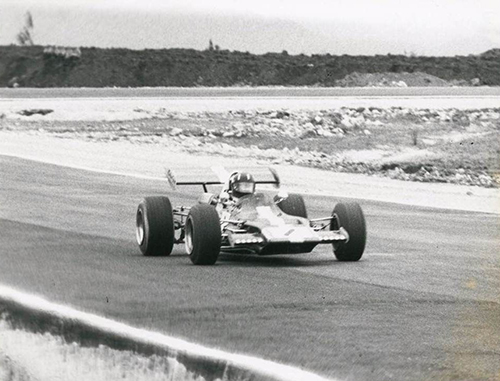
Graham Hill gets his first impressions of the Ricardo Mejia circui, aboard the Lotus-Cosworth 69.
(photo Javier Garrido Brito)
Another big name who showed interest was Jo Siffert - Chevron Racing Team, led obviously by the charismatic Swiss. The team, which was almost a full-works effort, would take two Chevron B18s to South American soil which, it was hoped, would prove to be competitive against the expected army of Brabhams and Lotus that would certainly appear on the circuit of the Colombian capital.
Even though the car is known as one of the ugliest single-seater designs ever made, it's undeniable that this was just a minor detail as long as the results were good. The thing is that by early 1971, this performance was based on pure speculation, as the car had raced only once in 1970!
Siffert would take his compatriot Xavier Perrot as his teammate, who was one of the many drivers who intermittently participated in F2 at the end of the sixties. Perrot was an experienced driver but always on the margin of expressive results, which are essential for any driver.
But without a doubt, the team that presented itself as the best candidate to sweep the trophies in the land of coffee was Frank Williams Racing Cars. mainly because it had the two factors that make up a good team, a promising car and two drivers of high caliber.
In the first case, a lot of faith was placed in the new March 712M that the team would take to its first trial by fire. The car was part of the second generation of vehicles produced by March Engineering, along with the 711 (F1) and the 713 (F3), and already showed a marked evolution compared to its predecessor: the change from the spaceframe chassis to a monocoque. This quickly proved to be the right choice for the team.
Even though the car still had to go through a series of fine-tuning tweaks to become the best F2 on the grid, the 712M was already a car on par with the venerable BT30 and Lotus 69 in Colombia. Certainly, having two drivers like Henri Pescarolo and Derek Bell were also factors that would contribute to the car's performance, in this stage of practical tests.
As early as 1971, Pescarolo had a gigantic résumé behind him, with participation in dozens of endurance events, having driven for Matra in a some F1 races, as well as being a regular driver in F2 and F3. Derek Bell was not far behind, because since 1968, the driver had thus far been part of the squads of Ferrari (F1 and WSC), McLaren (F1), Surtees (F5000) and Williams (F2). In addition, the driver was by the time the current F2 runner-up, having lost the 1970 title to Clay Regazzoni.
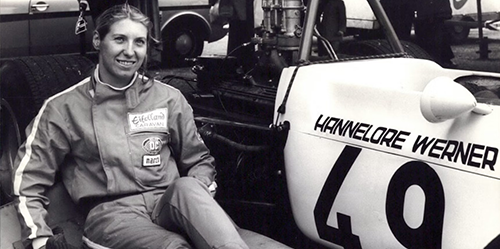
Hannelore Werner - the only female driver on the grid. This photo was taken in August 1970, before the 1970 Guards International F3 Trophy. (copyright WDR)
The highlight of the midfield teams was Eifelland Wohnwagenbau, which as its main bet had the German driver Rolf Stommelen. Even though the name Eifelland will always be linked to the team's infamous 1972 F1 venture, the team's history begins much more smoothly.
The project was conceived as a hobby of German motor home magnate Günther Henerici, who sponsored German drivers in F2 and F3 races – mainly in less publicised events where the competition was more open.
Much of Eifelland's trump cards in those F2 years (between 1969/70/71) were based on having Rolf Stommelen as their main driver, so that he could take better advantage of the average material that the team could offer. It's for that reason that when the team set sail for Bogotá, it was decided that Stommelen would have the 'best' equipment, a Brabham BT30. Meanwhile, his teammate, German driver Hannelore Werner, would have to accept a March 702.
A further half-dozen teams also confirmed their presence at the event: a true three-car effort would be made by the Paul Watson Racing Organisation: a Brabham BT23C for Brian Cullen; a Crosslé 18F for the Japanese Tetsu Ikuzawa, and a Lotus 'Frankenstein' (since this car was a hybrid Lotus 59/69) for Johnny Blades.
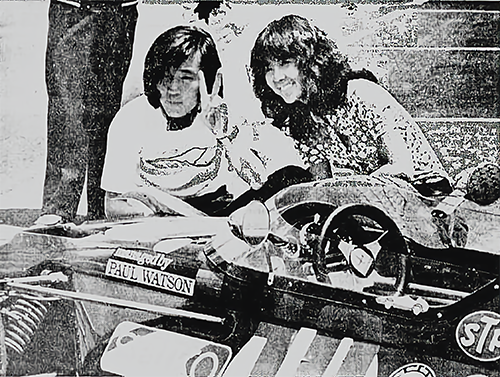
Tetsu Ikuzawa next to his wife. Despite poor performances in both rounds, Ikuzawa never failed to have a smile ready for the camera - a trademark of Japanese drivers. (photo Henrique Benavides)
The rest of the teams were one car, one driver: FIRST renewed its partnership with Peter Westbury, who had achieved consistent results with the team in the 1970 F2 season. The car this time was the same as last season: a Brabham BT30.
The Italians Jolly Club and Brescia Corse also headed towards the Americas. The first would have the services of the experienced Silvio Moser, who was well equipped with a Brabham BT30. Meanwhile, Brescia Corse would have to make do with a De Tomaso 103, with Italian Spartaco Dini at the wheel.
Also coming in this combo of sharpshooters: Alistair Walker Racing, with Alistair Walker himself as a driver (Brabham BT30), Team Obrist, with the Swiss Jürg Dubler (Brabham BT30), the Ian Bannen team, with Cyd Williams (Brabham BT30) and Irish Racing Cars, with Alan Rollinson (Brabham BT30).
There were hopes that Tecno could also attend (with French trio Jabouille, Jarier and Depailler, in addition to the current F2 world champion, Clay Regazzoni), but the team withdrew at the last minute. Thus, the final list was closed with 18 cars and drivers who would compete in both races at the Ricardo Mejía circuit.
Race 1: I Premio República de Colombia
As of February 1st, the first drivers who would take part in the event began to arrive in Colombian lands. In this first wave, the less famous drivers would arrive, since the big stars would only disembark closer to the end of the week.
The initial highlight was the German Hannelore Werner, the only woman who would compete in the Colombian Temporada. At this time, when the female presence on the grids of single-seaters was itself so rare, the case aroused even more interest in the Colombian press, which sought to explore as much as possible the story of the 28-year-old driver.
In an interview given to the Colombian newspaper El Tiempo on February 4, 1971, Werner stated that “Being hired to come to Colombia is a distinction, because they called me to compete with the best drivers in the world. And in these races, only those who truly know how to drive to the limit really compete”.
But the great expectation couldn't be less than Graham Hill, who would only arrive on Friday. The F1 star was the headliner for this championship, so it was to be expected that his arrival in Bogota would be a big event itself.
The first reconnaissance sessions were scheduled for 5th February, a Friday, at 11am, and with the anxiety of getting to know the unknown terrain, the drivers didn't take long to seize the opportunity.
What most tormented the lives of drivers and mechanics is that there were no parameters for comparison. Since the place was practically new and almost unknown (even for the Colombians themselves) neither the best set-up for the cars was known, nor was the ideal racing line, nor the way in which the asphalt would react to cars running at almost 250kph on its surface.
As soon as the track was cleared, which only happened at noon due to technical problems on the circuit, all the drivers dived into their cockpits, trying to find the best set-up for the machine to match the track.
The first to go onto the mysterious Ricardo Mejía circuit was Henri Pescarolo. On his first fast lap, the Frenchman set a time of 1:45.3; and, by the end of the session, he had dropped that to 1:29.7. Second best in that session was the experienced Silvio Moser, with a time almost seven seconds slower than Pescarolo. Others who tried their luck in that first session were Spartaco Dini and Tetsu Ikusawa, but neither managed to set a significant mark.
Running against the clock, Hill also managed to arrive on time for this session. The driver got off the plane that had brought him from England and went directly to the Ricardo Mejía circuit. This haste was of no avail, as in less than 400 meters on the track the Lotus 69 suffered from a torn water valve. The repair would be quick, but the car would only be ready for the second session.
After that first test, the track was closed for 15 minutes to analyse how the circuit responded to the cars. Seeing that the asphalt had behaved well, following the standards defined by F2, the drivers were released to the track again.
Times continued to go down and, this time, Rolf Stommelen came up with the best. With a time of 1:27.16, almost two seconds below Pescarolo's original mark, the German tried to impose himself against the competition.
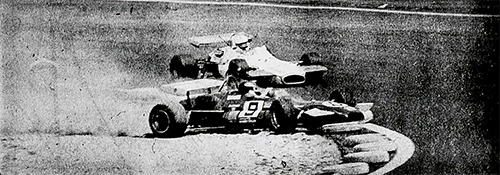
Alistair Walker (#9) and Rolf Stommelen (#21) in the Colombian GP on 7 February.
But the Frenchman responded in style, setting a time of 1:27.37. Therefore, only a tenuous difference separated the two best drivers so far. Graham Hill was another who sought to return to top form, having already managed to establish himself as third best.
The third free practice session, however, would be the turning point in this story. Firstly, because the first signs of wear and tear on the cars began to appear – mainly due to the rarefied air in Bogotá (since the city is 2,625m above sea level) and the heat in the place – since February is summer in the southern hemisphere.
The lack of oxygen with the heat was deadly for the machines. Pescarolo and Hill had problems with the gearbox sprockets, while Siffert suffered with the suspension of his Chevron.
The second event that happened was the spectacular performance of Alan Rollinson, who was the first to exceed the 27 seconds mark, setting a 1:26.31. While everyone had their share of problems, the Brit did a non-stop stint of 25 minutes, demonstrating that the Brabham was already feeling at home.
After another brief break, the track was cleared for the last time that Friday. Just when it looked like Stommelen had regained his rhythm, clocking a time of 1:25.63, Rollinson pulled a magic lap out of the hat: 1:25.06.
No-one could overtake the Briton that afternoon, but in the final minutes of the session, Stommelen still saw his second place become third, when another Brabham, this time the one of Peter Westbury, scored a 1:25.40.
It was already 4 o'clock in the afternoon when the first day of the F2 cars on the Ricardo Mejía circuit ended. The next day approached, and with it, another day-test of the Colombian F2 season.
A sunny Saturday morning soon descended on the circuit, making it clear that the final two sessions of official timekeeping would be inclement for cars and drivers alike. But it was the track itself that gave the first sign of wear, when a section of asphalt on the second corner rose, causing great concern for the organisers.
But the problem was solved, with the track ready for the timed session at noon. This session was also split into two, with both valid for the qualifying grid.
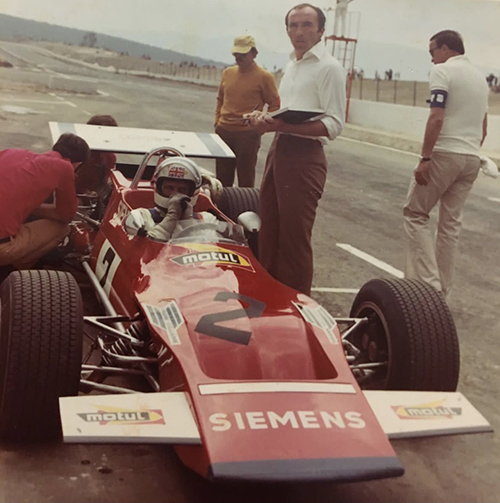
Frank Williams and Derek Bell during one of the practice sessions. (photo Diego Mejia)
The first was just for the teams to make the final adjustments to the cars, as the times were much higher compared to the day before. For example, the fastest driver in the first half was Jürg Dubler, with 1:27.11.
The drivers had agreed to give everything in the second part and so they did. Pescarolo did his best when he lowered his time to 1:25.37, still three tenths above Alan Rollinson's best time, but enough to secure second place on the grid for the Frenchman.
The Frank Williams Racing driver's time pushed the third and fourth places to Westbury and Stommelen respectively. Both failed to improve their times, having to settle with Friday's marks.
Rollinson held on to first place until the end of the session, when it soon became clear that no other competitor would match his mark. In an interview given even before the end of the session, the driver was already extremely optimistic about the next day:
“If I have the necessary luck, I believe that I will be among the first positions for tomorrow's race and I have a chance to win it. The machine is working like clockwork, I'm feeling comfortable on the track, so I can't ask for anything more than a little bit of luck to get my name on the track's honour roll.”
But expectations often do not come true, as the threshold between good luck and bad luck is tenuous. And the next day would prove it.
On that morning of February 7, 1971, Colombia was preparing to host its first international automobile race. The race would be split into two heats of 30 laps, with the combined time counting towards the drivers' final qualification. The grid in both heats would be the same, made up of the times scored in the qualifiers of the previous days.
After the official opening of the festivity by the Colombian president at the time (Misael Pastrana) the cars were authorised to line up on the grid for the first time. Rollinson would start on the inside, while Pescarolo would start on the outside.
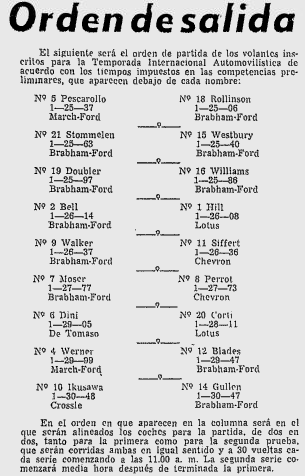
The grid for race 1.
And the duel for the lead soon took on dramatic contours in the first lap. After the start, Pescarolo jumped to first, leaving Rollinson in second. The Briton soon positioned himself at the rear of the March, trying to take advantage of the vacuum provided by the car. But that obstructed his vision and it was almost a fatal decision, when Pescarolo bumped into one of the tyres that aligned the tangents of the curves, and it went up into the air.
Rollinson tried to dodge the flying object, but it went directly into the Brabham. While the tyre flew over his head, it hit the car's rear wing and suspension. Even if he emerged unscathed from the accident, it was the end of the English driver's hopes of winning the race.
On the next lap, the same object caused a new accident, when Spartaco Dini had its front end destroyed by the out-of-control tyre. Two retirements in just two laps – the circuit was making its first victims. After the chaos of the first two laps, the race settled into a calmer pace. Jo Siffert had taken advantage of the confusion to take the second spot while Hill, who had started in the modest 7th position, took the third. Both Westbury and Stommelen had lost precious time bypassing the accidents.
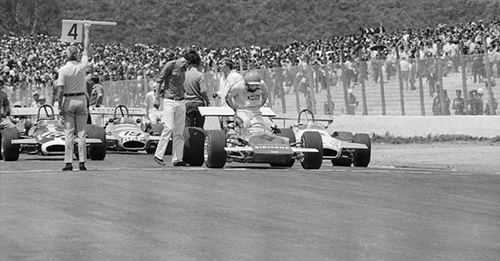
Start of the first race, 7 February 1971. In the pic are Henri Pescarolo (#5, centre), Peter Westbury (#15, left), Jürg Dubler (#19, middle), Rolf Stommelen (#21, right, behind Pescarolo). (photo Jabby Crombac)
But that peacefulness soon faded away, when Pescarolo's car began to emit suspicious smoke from the exhaust, close to the 12th lap. The Frenchman gradually slowed down until Siffert overtook the dying March. Soon after came Graham Hill and all 14 other cars still in the race. The March's Cosworth FVA engine had simply stalled due to an oil leak.
Now it was Switzerland leading the way, with just over half the race still to go. Siffert was trying to maintain a comfortable lead over Hill, who was now threatened by Jürg Dubler.
Siffert looked to have the win well under way, until the Chevron's engine began to also develop problems on lap 21, when one of the engine's spark plugs failed. The car was now running on three cylinders!
Fortunately for Siffert, the battle between Hill and Dubler increased in intensity, which did not allow either pursuer to get closer. Siffert's concerns were only reignited in the final laps, when Dubler pulled off a spectacular move and finally overtook Hill.
But it was too late to catch the Chevron, and Siffert crossed the finish line first, with a time of 45:48.3, two seconds ahead of Jürg Dubler. Hill came third, a minute behind, after making an error on the penultimate lap.
Half an hour of rest for drivers and machines, so that the grid could be realigned for the second heat. Neither Pescarolo nor Rollinson would start, so Westbury and Stommelen were promoted to positions 1 and 2, respectively.
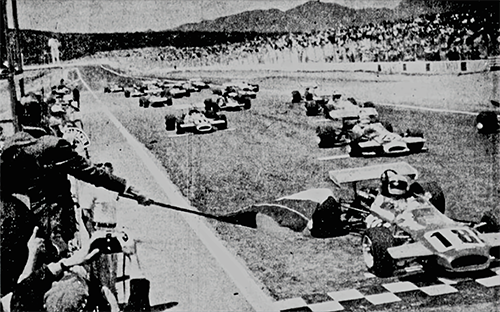
Another picture of the start. (photo Henrique Benavides)
But this was Siffert's day. After resolving the engine problems in the interval between heats, the Swiss quickly repeated his performance in the first stage when in a few laps he took first position. At his heels was Hill, who was trying not to lose sight of the Swiss.
Derek Bell was another one who resurfaced in the second stage, after all the problems the driver had faced so far. Bell was already approaching the leaders, as the cars in front of him began to struggle.
Siffert was already more than 20 seconds ahead of Hill, when a new accident disrupted the course of the race. This time the protagonist was the British Cyd Williams.
At the start of the ninth lap, the driver was in fourth position, a few seconds behind Dubler, who was in third. When approaching the first corner, the Englishman pushed his vehicle to the maximum, trying to gain precious tenths.
As Williams pressed the brake pedal to the maximum, the car locked its wheels, and the left rear tyre, which was already worn out, could not withstand the pressure of the move and burst, causing the car to roll over several times, stopping only at a protective fence at the side of the track.
Miraculously, the pilot emerged with only minor abrasions. On the other hand, his purple Brabham was destroyed by the accident. Soon after the crash, Williams commented to the press, saying that "I didn't have time to be afraid, because everything at that speed happens in an instant, and you only realise that you no longer have control over the machine". According to witnesses at the time, it is stipulated that the driver had approached 250kph near the crash point.
Even with the accident, the race did not stop. Siffert continued to pull away from Hill, who held a secure second position. Dubler, who was third, had problems with the gearbox and had to retire on the 13th lap. Over the following laps, the third position passed through a relay: first with Alistair Walker, who on lap 15 gave up the position to Enzo Corti, after a pit stop. But three laps later, the Italian lost the position when one of his spark plugs burst, and so it was Derek Bell's turn to take third place, which was 'almost' secure.
'Almost' because on the last laps, it was Graham Hill's turn to have problems with the car. The Lotus became a difficult car to control and the Englishman began to lose pace, being passed by both Bell and Walker in the final laps.
Jo 'Seppi' Siffert was not even aware of these problems, as the Swiss crossed the finish line almost 1 minute ahead of Derek Bell. The driver swept Sunday, winning both races and securing victory in the I Premio República de Colombia, with a combined time of 1'34:27.7.
Despite his problems in the second heat, Hill finished second overall, with a deficit of 2 minutes and 15 seconds. Completing the podium was Peter Westbury, a lap behind the top two.

The result for race 1.
The race was a success for the Colombian organisers, with many disputes and dramatic moments, which set the tone for a good GP. In addition, more than 35,000 spectators were counted on Sunday, a number that was expected to be much higher in the next race, scheduled for the 14th.
Race 2: Premio Ciudad de Bogotá
After four days of rest, in which the drivers were able to enjoy the different facets of the Latin American country (for example, Hill left for the beaches bathed by the Caribbean Sea, while Moser, Pescarolo and Siffert made an expedition through the Amazon rainforest), they all gathered again for the initial preparations of the second leg of the Colombian F2 Temporada.
Before the cars could go back to the track, the Ricardo Mejía circuit underwent a series of minor modifications, following the lessons of the first race. The main one was the removal of the tyres that delimited the tangents of the curves, which would now be made by small curbs and escape areas in concrete. This was mainly due to the accidents of the 7th, in which the tyres almost caused two extremely serious accidents.
The asphalt, which was also one of the targets of criticism from the drivers, was redone in certain parts, so that the drivers had a more relaxed and smooth driving experience.
When the cars were released again to go to the track, on Friday (12), Alan Rollinson shone again. With his car already repaired, after his near-fatal encounter with the flying tyre the last Sunday, the Briton set the best time in the first practice session: 1:29.97.
In the second session, Siffert tried to respond, managing to set a time of 1:27. 75. The winner of the first race would not let the pace drop, making all the competitors try their hardest to reach their mark. Even so, the times were still above, if compared to those established in the first weekend.
The clearance of the track for the third part of practice sessions was delayed a little, due to complaints from the drivers about the amount of dirt and garbage on the track. After a complete cleaning of the site, at three o'clock in the afternoon, the machines returned to the 3925m long circuit.
This was the most interesting part of the practice sessions, mainly due to the dispute on the track which was more like a race in itself than a simple timed session. Alan Rollinson and Siffert took to the track again, trying to lower their times even further. Only the former had this pleasure when on one of the laps, the Briton managed to lower the mark to 1:26.58, at an average speed of 163.201kph.
Siffert, on the other hand, saw his time being dropped by more and more drivers: after Rollinson, it was Hill's turn, with 1:27.22. Soon after came Westbury and Stommelen, setting quicker times than the Swiss, so by the end of the third session, Siffert had dropped from first to fifth fastest.
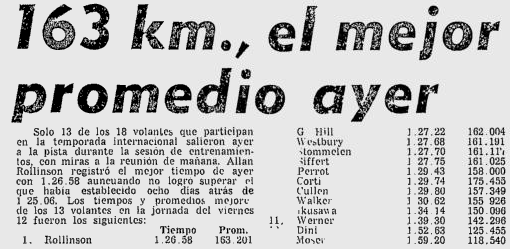
The grid for race 2.
Siffert's luck was that his performance could have been even worse, if other drivers like Pescarolo, Bell and Dubler had participated in the practice sessions. The first two had their cars being repaired in the workshops, while the Swiss was waiting for a replacement gearbox. Cyd Williams was also unable to go on track, as he was waiting for spare parts for his car, while Johnny Blades had a serious headache with his Lotus.
As the drivers prepared for their fourth practice session, torrential rain fell on the circuit. Not knowing at what time the downpour would end, the teams waited – until the decision to cancel the last session was taken jointly by the organisers and drivers. Practice would only return the following day, with the expectation that all machines would be ready by then.
Friday passed and Saturday arrived, but one thing that hadn't changed was the weather in the Colombian capital. Meteorological instability began to play its tricks and any small opportunity to set the best time should be taken advantage of.
And Jo Siffert took full benefit of one of them, when he set the circuit's absolute record, with a spectacular lap of 1:24.82. The closest to come to the mark set by the Swiss was Henri Pescarolo, with a time of 1:24.94, and the only other driver below the 1:25s was Stommelen with a time two hundredths better than Pescarolo. Rollinson, who had so far been the fastest driver on the track, had to settle with sixth.
The same formula of the first leg would be repeated again: two heats with 30 laps each, the sum of both parts valid for the final result – whoever had the lowest combined time would reap the laurels of being the winner of the Premio Ciudad De Bogota. The only notable difference is that in this weekend the cars would race counter-clockwise (as opposed to the first, where the cars followed the hands of the clock).
The day was mild, with better weather than the previous two days. Even dodging the weather problem, the organisers got themselves into problems again when the official start was delayed by 40 minutes, due to 'technical reasons'.
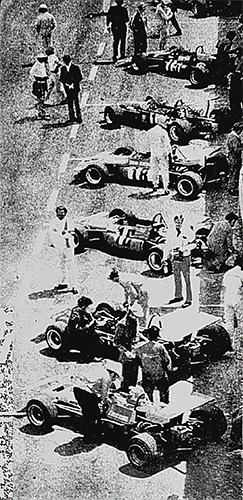
Getting ready for race 2 on 14 February. (photo Henrique Benavides)
But with a few minutes to go before noon, the 18 cars fired into the first of 30 laps of heat 1. Siffert quickly managed to secure the top position, leaving no room for aggressive maneuvering by his opponents. Feeling overwhelmed by Siffert's great start, Henri Pescarolo and Rolf Stommelen soon got involved in a personal dispute for second position. But this meeting did not last long, as just five laps later, the Frenchman suffered problems with his distributor and was forced to retire from the race.
Right behind the ill-fated Frank Williams Racing driver followed a small skirmish between Dubler and Rollinson, who had already opened a small advantage on their most direct pursuers Xavier Perrot, Peter Westbury and Alistair Walker.
Meanwhile, both Lotus and Graham Hill sought to recover in the race: after problems at the first lap, where the car did not start due to a failure in the fuel injection system, the driver was already in the middle of the pack.
The battle between Dubler and Rollinson heated up, until it reached its climax when the Briton managed to overtake the Swiss. By lap 20, the order of the top six was Jo Siffert, Rolf Stommelen, Alan Rollinson, Jürg Dubler, Peter Westbury and Alistair Walker.
Jo Siffert tried to set a comfortable advantage over Stommelen, who stabilised around ten seconds. Dubler had lost a bit of pace near the last moments of the heat, being surpassed successively by Westbury and Walker.
Even if he eased the pace in the final laps, Siffert did not miss the chance to cross the finish line in first place once again. Close behind came Stommelen and Rollinson who witnessed another Chevron triumph.
After an half-hour break everyone was ready for the second and final heat of that weekend. For the last time, the starting signal was given for the F2 cars on the circuit. And who did better this time was Alistair Walker and his Brabham BT30, who jumped from seventh to first in less than a lap.
Rollinson was also another one who had a great start, going from sixth to third in a few corners. The Briton was only behind Walker himself and Siffert, who managed to hold on to second place.
The driver continuing his streak of bad luck was Pescarolo. In addition to having to start from last position in that heat, due to being late in lining up on the grid, the Frenchman started to have handling issues with the March on lap 6, due to sustained damage to the front wing. The driver was forced to make a long pit stop to try to fix the problem.
A little earlier on lap 5, however, the Frenchman still saw Siffert overtaking Walker for the lead. After this move, the race took on a calm course, marked only by occasional retirements.
The first to leave was Hannelore Werner, who had come to Colombia with so much expectation: if in the first heat the driver had finished only in 13th position, in this one she would not even manage to cross the finish line. On lap 10, the German lost control of her car at La Herradura corner, seriously damaging the machine. Luckily, she was another one who came out of a serious accident unscathed.
The next driver to say goodbye was Pescarolo, who finally gave up on lap 19. After fixing his wing problem, the Frenchman suffered an electrical fire. On lap 20, it was Dubler's turn, with engine problems. On the next lap the unlucky driver was Xavier Perrot who had gear shift linkage problems in his Chevron. Between laps 23 and 24 there were two more retirements: Cyd Williams (fuel pump belt) and Alistair Walker (piston).
That was unfortunate for Walker who was leading the race after Siffert started experiencing problems with his car. You read it right because the hitherto unstoppable Swiss seemed to have found his biggest opponent so far: the car itself.
A little after lap 20, Siffert's Cosworth FVA/Hart engine began to splutter, and to avoid further damage the driver chose to slow down as it was enough for him to finish the race to be crowned champion of the Colombian Temporada.
And so, the Swiss didn't try too hard to defend the first position, which was quickly taken by Walker. Soon after came Rollinson, Stommelen and Bell, with Siffert struggling to continue at a minimally competitive pace. But the Swiss' hopes were dashed, when with just two laps to go the car simply died with distributor problems.
Capitalising on the issues of his opponents was Alan Rollinson who in a few laps went from third to first. The Briton would not be hurt by problems until the end of the race, as Derek Bell took it upon himself to torment second-place Stommelen's life. And this tactic did work when with three laps to go Bell found an opening and managed to overtake Stommelen, thus taking second place.
In this way Rollinson calmly crossed the finish line in first place, with a margin of seven seconds over Bell. Surprisingly, not Stommelen but Peter Westbury was third, as the British driver executed a spectacular move with one lap to go, securing his place in the top three.
After summing up the heat times, Alan Rollinson was declared the winner of the Premio Ciudad de Bogota, with a total time of 1'28:05 – thus crowning one of the most regular drivers of the Colombian F2 season. A few seconds behind came the second best, Rolf Stommelen, and completing the podium was British driver Derek Bell.
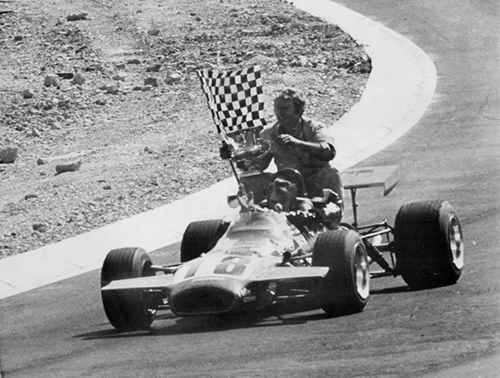
Allan Rollinson celebrating his victory in the Gran Premio Ciudad de Bogotá. (photo Javier Garrido Brito)
Even though losing the race trophy by a measly eight seconds, Stommelen was rewarded to some extent by being the overall champion of the 1971 Colombian F2 Temporada. The German clinched the result due to his regularity in the four heats (that is, the total of the two races) while his direct opponents – Siffert, Rollinson and Dubler – had problems in at least one of them.
So, that was the end of this adventure in the tropics – and obviously, it was another one of those unique stories that always give motorsport a good-humoured tone. With lighter spirits and minds, it was now time to return to Europe, for another year to remember.
Why to read me?
In the year of its construction, the Ricardo Mejía circuit was one of the highest in the world. Located at more than 2600m above the sea level, the track added another danger, in the long list of those that already existed in motorsport at the time: the lack of oxygen.
Since all the cars on the grid were prepared to run close to sea level, where the proportion of oxygen in the air is much higher compared to the Colombian capital, the teams soon became concerned with the durability of the components, especially the engines. It was assumed that these could have serious reliability problems, even more so because the formula cars of the sixties were very sensitive machines.
As if the peculiarity of these characteristics were suspected, the action taken was quick and decisive. There were changes in the fuel injection system and in the mixture ratio, to compensate for the rarefied air; the compression ratio was also rectified, thus recovering the lost horsepower.
It quickly proved to be the right decision, with most of the cars going smoothly through the first weekend. But, with the second week already in sights, it was clear that the altitude was starting to take its toll, with the high attrition rate the machines faced.
Gearbox changes were common, along with engine problems of all kinds. It didn't seem clear to the organisers, but these little things that bothered teams and drivers were among the factors that condemned that 1971 edition to be the first and last season of F2 in Colombia.
The emergence of successive generations of talented drivers in a South American neighbour – Brazil – was also destructive for the long-term prospects of Colombian motorsport. The country of carnival and samba which has always had a strong tradition in motorsport (in addition to being an economic power in Latin America) now had the trump card it needed to jump into the spotlights of world motorsport.
Thus, Colombia had to settle with ostracism once again, only returning to motorsport when the likes of Roberto Guerrero, Juan Pablo Montoya and Tatiana Calderón took the tricolour flag from the coffee land back into the international headlines once more.
Acknowledgements
- El Tiempo newspaper: editions from 4th to 15th February 1971
- OldRacingCars
- The FastLane
